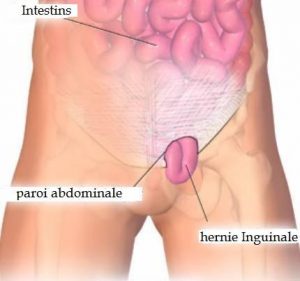laparoscopic inguinal hernia
Definition
 Inguinal hernia repair is often performed under laparoscopy on an outpatient basis.
Inguinal hernia repair is often performed under laparoscopy on an outpatient basis.
Outpatient treatment
The majority of hernias are now operated on an outpatient basis. This technique is intended for patients in good general condition, accompanied, whose home is close to the hospital (less than 45 minutes). This procedure requires team management with good coordination between caregivers, anesthetist and surgeon. The patient is prepared for this intervention from the consultation. He must take a shower with hibiscrub (surgical soap) the day before and the morning of the procedure. The prescription for postoperative analgesics is entrusted to the patient during this preoperative consultation so that the treatment can be purchased at the pharmacy before the intervention. The day before the operation, the patient eats normally. It is advisable to have a light meal in the evening. Hospitalization takes place at 7am. The patient must be strictly on an empty stomach. When she arrives in the outpatient department, the nurse checks her file and puts the patient in compression stockings to prevent the possible occurrence of phlebitis. On his return from the block, a light meal is served to the patient. One of the keys to the success of this treatment, apart from the surgery itself, is early rehabilitation. The patient is asked to get up, move around and eat as soon as possible. Discharge is authorized after a visit by the anesthetist and the surgeon between 4 and 6 p.m. The pain must be tolerable (it's more of an annoyance) and slow walking must be possible. The surgeon ensures that the patient was able to eat and was able to go to the toilet without difficulty.
Classic support
If the patient does not meet the conditions for outpatient surgery, entry into the service takes place the day before the operation. There is a skin preparation of the operating area (antiseptic shower and localized depilation)
She is short, under general anesthesia. The patient is taken to the operating theater in the morning on an empty stomach with an infusion. The intervention begins as soon as the general anesthesia is done. It consists in closing and reinforcing the parietal orifice. In laparoscopy, the surgeon uses a non-absorbable parietal prosthesis ("plate"). Drinks and a light meal are authorized upon return from the block. In any case, an early rise is advised.
The day after the operation, the patient is fed normally and discharge is prepared. the patient leaves the department with an analgesic and anti-inflammatory prescription. The work stoppage is 15 days or 1 month in the case of a forced worker. After hospitalization, a consultation with the surgeon is scheduled one month from the date of surgery.
Young patients are preferentially treated on an outpatient basis. Wearing SERRES BRIEFS improves patient comfort.
Incidents and complications
Bruise this incident is not serious. It results in the appearance of a "blue" on the penis or scrotum. This coloration is painless and may appear secondarily (8 to 24 hours later). It usually disappears in 8 to 10 days. There is no particular treatment. A deep hematoma may occur. It is responsible for prolonged pain and increased incapacity for work. The regression is done in 4 to 6 months.
Pain after surgery< strong>inguinal hernia, the pain is moderate. At rest, comfort is restored in 3 to 4 days and on exertion there is usually a feeling of local tension for a fortnight. Pain medication should be taken systematically. In some cases the method of fixing the prosthesis can be responsible for pain. If staples are used, the pain subsides as the staples resorb.
Collection a small local collection can occur at the old hernia site mimicking hernia recurrence. In the majority of cases, it is a liquid collection called "seroma". This temporary local bulge is painless. This rare problem occurs more often than the hernia is old and bulky.
Healing in case of biological glue dressing, the flow of water during the shower does not pose any problem. There is no risk of superinfection. Wearing a seat belt is often embarrassing at first because of the contact between the scars and the seat belt, especially when sitting. In this case, it is advisable to wear "jogging" type pants.
Recurrence regardless of technique used by the surgeon, there is a risk of recurrence. This problem can occur remotely from the intervention but sometimes also quite early if the prosthesis slips. This slippage is favored by too early resuming of intense efforts or by unfavorable local conditions (large old hernia, recurrence after classic technique).
Prosthesis infection this complication is rare. It results in pain associated with unexplained fever and chronic suppuration on a skin orifice. An antibiotic treatment can be tried but the cure is most often obtained only at the cost of a reoperation which consists in removing the prosthesis.
Antibioprophylaxis
To reduce the risk of surgical site infection, learned societies have drawn up recommendations that validate the use of antibiotics during surgery. These indications are well known to anesthesiologists who, like your surgeon, are very oriented towards this problem of preventing infectious complications.